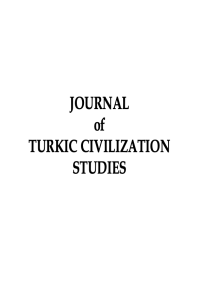Öz
This article focuses on the development of horse breeding in Central Asia in the Mediaeval Ages. As it is known, on the eve of the Arab conquest, Central Asia was inhabited by the Sogdians, Bactrians, Khorezmians and the Turkic people. Indeed, the Turks had a political power in the Ancient Turkic Khanate and they inhabited whole Central Asia, from steppes to mountains, from towns to villages. Horse was important for most of the people living in Central Asia, but it had a special place among the Turkic people. For instance, among all people living in Central Asia in the Middle Ages, the Turks were the only people eating horse meat. Moreover, according to the Chinese sources, the Turks had a tradition of sacrificing the horse. Furthermore, Arabic sources have also emphasized the importance of horse meat in the Turkic culture. For instance, Ibn Fadlan recorded that the Oghuzs had a tradition of burying a person together with his/her horse. In sum, this article underlines the place of “horse cult”, that is, material and spiritual importance of the horse in the Turkic culture, history and everyday life.
Anahtar Kelimeler
Kaynakça
- Бернштам А.Н. Древнетюркский документ из Согда // Эпиграфика Востока, вып. 5, М.; Л., 1951. С. 71.
- Путешествие Ибн Фадлана на Волгу / Перевод и комментарий под редакцией И.Ю. Крачковского. М.; Л.: Изд-во АН СССР, 1939. С. 63. al-Jakubi, р. 295.
- Ал-Идриси. Китаб нузхат ал-муштак фи-хтирак ал-афак (Развлечение истомленного и странствование по областям [Вселенной] ) / Перевод с арабского Ш.Закирова // Материалы по этнической истории тюркских народов Центральной Азии. Ташкент: Фан, 2003. С. 56, 60.
- Из сочинения Ибн Фадлаллаха ал-Омари (ХIV в.) // Золотая Орда в источниках. Том первый. Арабские и персидские источники. Сборник материалов, относящихся к истории Золотой Орды в переводах В.Г.Тизенгаузена. Составление, вводная статья и комментарии Р.П.Храпачевского. М., 2003. С. 102; Из описания путешествий Ибн Батуты // Золотая Орда в источниках. Том первый. Арабские и персидские источники. Сборник материалов, относящихся к истории Золотой Орды в переводах В.Г.Тизенгаузена. Составление, вводная статья и комментарии Р.П.Храпачевского. М., 2003.. С. 128, 129, 139, 141.
- Амин ал-Холи. Связи между Египтом и Волгой в ХIII – ХIV вв. Сокращенный перевод с арабского. М.: Наука, 1962. С. 23.
- В средние века конину употребляли не только кочевые тюрки, но также оседло- земледельческие и городские тюрки. Что касается персов, согдийцев и других иранских народов, то они, также как арабы, сирийцы и иудеи, как известно, конину вообще никогда не употребляли.
Öz
This article focuses on the development of horse breeding in Central Asia in the Mediaeval Ages. As it is known, on the eve of the Arab conquest, Central Asia was inhabited by the Sogdians, Bactrians, Khorezmians and the Turkic people. Indeed, the Turks had a political power in the Ancient Turkic Khanate and they inhabited whole Central Asia, from steppes to mountains, from towns to villages. Horse was important for most of the people living in Central Asia, but it had a special place among the Turkic people. For instance, among all people living in Central Asia in the Middle Ages, the Turks were the only people eating horse meat. Moreover, according to the Chinese sources, the Turks had a tradition of sacrificing the horse. Furthermore, Arabic sources have also emphasized the importance of horse meat in the Turkic culture. For instance, Ibn Fadlan recorded that the Oghuzs had a tradition of burying a person together with his/her horse. In sum, this article underlines the place of “horse cult”, that is, material and spiritual importance of the horse in the Turkic culture, history and everyday life.
Anahtar Kelimeler
Kaynakça
- Бернштам А.Н. Древнетюркский документ из Согда // Эпиграфика Востока, вып. 5, М.; Л., 1951. С. 71.
- Путешествие Ибн Фадлана на Волгу / Перевод и комментарий под редакцией И.Ю. Крачковского. М.; Л.: Изд-во АН СССР, 1939. С. 63. al-Jakubi, р. 295.
- Ал-Идриси. Китаб нузхат ал-муштак фи-хтирак ал-афак (Развлечение истомленного и странствование по областям [Вселенной] ) / Перевод с арабского Ш.Закирова // Материалы по этнической истории тюркских народов Центральной Азии. Ташкент: Фан, 2003. С. 56, 60.
- Из сочинения Ибн Фадлаллаха ал-Омари (ХIV в.) // Золотая Орда в источниках. Том первый. Арабские и персидские источники. Сборник материалов, относящихся к истории Золотой Орды в переводах В.Г.Тизенгаузена. Составление, вводная статья и комментарии Р.П.Храпачевского. М., 2003. С. 102; Из описания путешествий Ибн Батуты // Золотая Орда в источниках. Том первый. Арабские и персидские источники. Сборник материалов, относящихся к истории Золотой Орды в переводах В.Г.Тизенгаузена. Составление, вводная статья и комментарии Р.П.Храпачевского. М., 2003.. С. 128, 129, 139, 141.
- Амин ал-Холи. Связи между Египтом и Волгой в ХIII – ХIV вв. Сокращенный перевод с арабского. М.: Наука, 1962. С. 23.
- В средние века конину употребляли не только кочевые тюрки, но также оседло- земледельческие и городские тюрки. Что касается персов, согдийцев и других иранских народов, то они, также как арабы, сирийцы и иудеи, как известно, конину вообще никогда не употребляли.
Ayrıntılar
| Birincil Dil | Rusça |
|---|---|
| Konular | Endüstri Sosyolojisi |
| Bölüm | Araştırma Makalesi |
| Yazarlar | |
| Yayımlanma Tarihi | 30 Haziran 2006 |
| Yayımlandığı Sayı | Yıl 2006 Cilt: 2 Sayı: 1 |
Journal of Turkic Civilization Studies © 2022 by TUAUM is licensed under Attribution-NonCommercial 4.0 International
Journal of Turkic Civilization Studies by TUAUM is licensed under Attribution-NonCommercial 4.0 International


